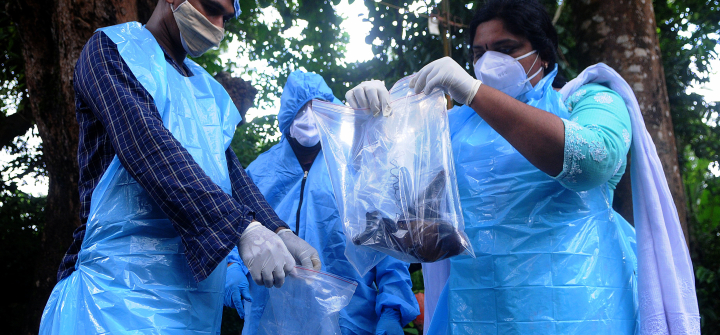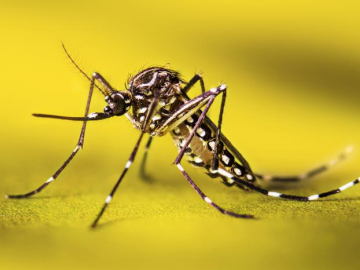Outbreak Preparedness for All
At the height of the COVID-19 pandemic, for the first time in living memory, the global population got a crash course in public health, the processes of outbreak response, and all the terminology that goes along with it. In the race to digest what was happening, public health processes and roles were not always explained well and terms were often misused, revealing how much still needed to be learned.
The Outbreak Atlas, a new book aimed at “armchair epidemiologists” and public health professionals alike, aims to clarify and demystify outbreak preparedness, response, and recovery, with the help of case studies from disease outbreaks across the globe.
GHN spoke with co-authors Rebecca Katz, a professor and director of the Center for Global Health Science and Security at Georgetown University Medical Center, and Mackenzie Moore, a PhD candidate and Wellcome Trust Scholar at University of Edinburgh, about their quest to make outbreak knowledge accessible to all.
Why did you write this book?
Rebecca Katz: During the pandemic, people in the global health security space were getting lots of questions. Then you’d go out to the store to the grocery store and people are talking about things like case fatality rates, or epi curves, prevalence, superspreaders, R0, quarantine. It was a little Twilight-Zoney for us. These are terms we just never teach until grad school.
Mackenzie Moore: People were exposed to these terms because they were being used by their local politicians. They were being shown on the news every night—not always accurately—and without any definitions or background about what this language means.
How do you want people to use the book?
RK: There are a range of activities that happen in an outbreak, and no one person does all of them. Our aim was to explain how diverse a response is—from the core epidemiology, the who, what, where, and why—to the laboratory, diagnostic space, to the clinical space, to the logistics, to the security aspects, to how you pay for it all, to the governance aspects. It’s not meant to be read top to bottom, but it was important for us to include that whole range.
MM: Even before you get to the response part, we wanted to reinforce how important the foundation of outbreak preparedness is. For example, a trained workforce already having a positive relationship with communities—or having lab capacity in case, all of a sudden, 20 samples need to be sequenced in a day. Leading up to and during an outbreak, that awareness of what’s going on allows people to be a bit more engaged. Understanding what good science is also allows people to be a bit more critical about the information they’re receiving. Maybe you don’t understand every term, but maybe you take a second look when someone says, “This is the miracle drug cure,” and it’s only been tested on five people—maybe it’s not the best thing.
How would this book be different if you’d written it in 2019, before the COVID pandemic?
MM: The communication section around misinformation and disinformation, and overall community trust and science, has become more of a focus. Vaccine distrust has been around since the late 1990s, but we’d never seen it become a driver for overall science disbelief the way we did during COVID. That’s something we previously had rose-tinted glasses on about. We thought, this is science, and when this happens this is how we should respond. We’ve had to go back and tweak the language a little bit to say, “Here’s what should happen, but if it doesn’t, here’s how to handle it.”
RK: Before COVID, we also had talked for years about the potential role of military assets supporting a civilian response. But there’s a huge difference between talking about it and seeing a hospital ship roll into New York harbor. Getting one’s head around those pieces that went from being theoretical to actual work, that was an experience.
But the book goes well beyond COVID-19. How do best practices vary from disease to disease, or from place to place?
RK: The science of outbreak response is the same—the variables are about context. In some places we may think about resource limitations; in other places, about the way that people are communicating, or who the local leaders are, or how people access health care—if they are able to at all—and how that influences the way an outbreak evolves.
MM: We included about 175 outbreak case studies and fun facts covering a range of diseases and a global geographic range. What’s been done in one outbreak doesn’t mean that another country is going to take the same steps. But when you pull all of these steps together it might be helpful and inspire someone to say, “Hey, it works there? Maybe we can try it here.”
Can you describe one of those case studies where effective interventions stopped an outbreak from getting out of control?
MM: In 2007, a mountain biking race in British Columbia was really muddy, and a bunch of participants got Campylobacter infection from ingesting mud during the race. Initially doctors didn’t know why people were getting sick, but an epidemiologist looked at mountain biking forums after the event and found hundreds of posts about sick riders. They were able to put the word out that more doctors should be testing for it. The mountain bikers were also being proactive and saying, “Hey, a bunch of us have this thing. Maybe someone should take a closer look at it.” As a result, that outbreak was confined, and wasn’t as big as it could have been.
RK: Other examples include the rapid response mounted to Nipah virus outbreaks in Kerala, India, and exceptional surveillance and response activities that contained the number of cases in some Ebola outbreaks. We see this all the time, and it’s exciting because it saves lives.
This interview has been lightly edited for length and clarity.
Join the 50,000+ subscribers in 170+ countries who rely on Global Health NOW summaries and exclusive articles for the latest public health news. Sign up for our free weekday newsletter, and please share the link with friends and colleagues: https://www.globalhealthnow.org/subscribe.
Officials deposit a bat into a plastic bag after catching it, in Kozhikode, India, on September 7, 2021. C. K Thanseer/DeFodi Images via Getty





